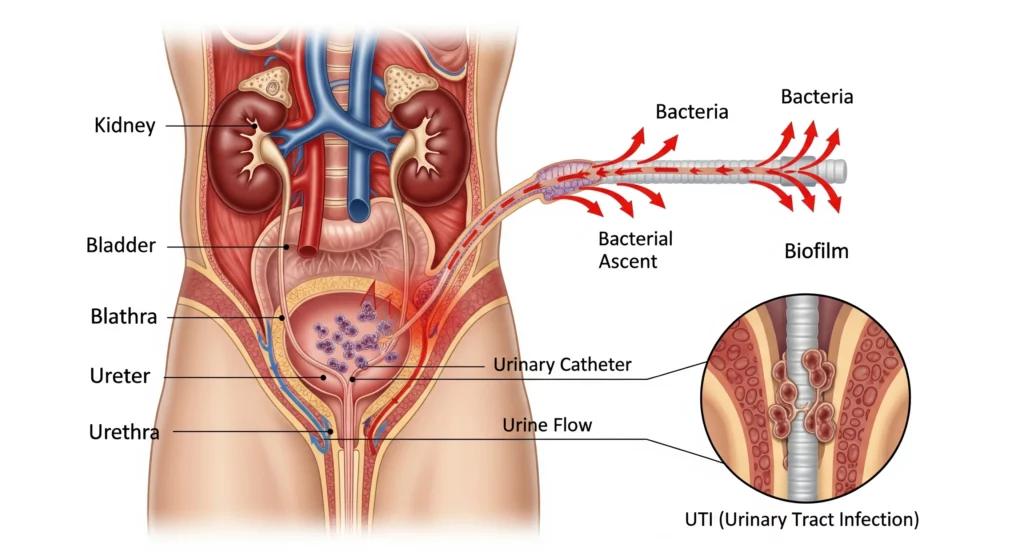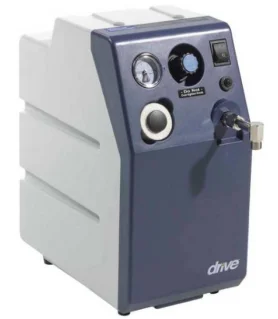Early Signs of Catheter Infection & How to Prevent UTIs
Key Takeaways
- Know the Early Signs: Watch for changes in urine (cloudy, smelly), fever, chills, increased bladder spasms, lower belly pain, or new confusion (especially in older adults).
- Good Hygiene is Crucial: Always wash hands well before and after touching the catheter. Clean the catheter site daily with mild soap and water, wiping away from the body.
- Manage Your Drainage Bag: Keep the bag below your bladder, empty it regularly (half full or every 8 hours), and avoid touching the drainage spout to anything dirty.
- Stay Hydrated: Drinking plenty of water helps flush bacteria out of your system.

Why Catheter Users Are at Higher Risk for UTIs
Using a catheter creates a direct path for germs (bacteria) to enter the bladder and urinary system. Even with careful cleaning, having a foreign object in the body and continuous drainage can weaken the body’s natural defenses. Bacteria can stick to the catheter, forming a sticky film that’s hard to get rid of, which can lead to infection. The longer a catheter stays in place, the higher the risk.
Early Signs of Catheter Infection & UTI Symptoms
For people using catheters, the usual UTI symptoms like painful urination might not be there, or they might be different. It’s important for caregivers and users to pay close attention to more subtle or different signs. Catching these early signs of catheter infection can lead to quicker treatment and better outcomes.
Here’s what to look for:
- Changes in Urine:
- Cloudy urine: Your urine might look murky or hazy.
- Foul-smelling urine: The urine might have a strong, unpleasant odor.
- Presence of blood (hematuria): You might notice pink, red, or brownish urine.
- Fever and Chills: A rise in body temperature, even a slight one, possibly with shivering or feeling cold.
- Increased Bladder Spasms: More frequent or stronger urges to urinate, even if the bladder is empty, or discomfort in the bladder area.
- Lower Abdominal or Flank Pain: Discomfort or pain in the lower belly, lower back, or side.
- Leakage Around the Catheter: This can sometimes mean there’s a blockage or irritation, which can lead to infection.
- Confusion or Lethargy: Especially in older adults, new confusion, disorientation, or a big drop in energy can be a main sign of infection.
How to Prevent UTIs with Urinary Catheters: Essential Care Tips
Careful and consistent hygiene is the most important way to prevent UTIs when using a catheter. Following these steps consistently and correctly is vital.
1. Hand Hygiene and Glove Use
- Always Wash Hands: Before and after touching any part of the catheter system (catheter, tubing, drainage bag), always wash your hands thoroughly with soap and water for at least 20 seconds.
- Use Gloves: Use clean, disposable gloves when doing catheter care, especially when inserting, disconnecting, or emptying the drainage bag. This adds an extra layer of protection against germs.
2. Cleaning the Catheter Site
- Daily Cleaning: Clean the area around where the catheter enters your body (the urethral opening for urethral catheters, or the stoma site for suprapubic catheters) at least once a day, or more often if there’s discharge or after a bowel movement. Use mild, fragrance-free soap and warm water.
- Direction of Cleaning: For females, wipe from front to back (from the urethra towards the anus). For males, clean the tip of the penis in a circular motion, moving away from the urethra.
- Catheter Tube Cleaning: Gently clean the part of the catheter tube you can see, moving away from your body. This helps prevent pushing germs towards the insertion site.
- Avoid Harsh Products: Do not use strong antiseptic solutions, powders, or creams around the insertion site unless your doctor or nurse specifically tells you to. These can cause irritation.
3. Managing Your Drainage Bag
- Keep Below Bladder: Always make sure the drainage bag is placed below the level of your bladder. This stops urine from flowing back into your bladder, which can carry germs. Never let the bag rest on the floor.
- Empty Regularly: Empty the drainage bag when it’s about half full, or at least every 8 hours. Use a clean, separate container to collect the urine. Be careful not to touch the drainage spout to the collecting container.
- Night Bags: For overnight use, a larger night bag can be connected. Make sure the connection is secure and the system stays closed.
- Bag Cleaning (for reusable systems): If your drainage bag is reusable (like some leg bags), clean it well following the manufacturer’s instructions. This usually involves a solution of vinegar and water or a mild disinfectant, followed by rinsing and air drying. Many systems today are for single-use only.
4. Catheter Insertion/Changing Best Practices (for Intermittent Catheters)
- Single-Use Catheters: If you use intermittent catheters, never reuse them. Each catheter is meant for a single use and is sterile. Always use a new, sterile catheter each time you insert it. Most insurance plans cover enough catheters for this practice. Learn more about exactly how much of each type of catheter supplies your insurance covers here.
- Clean Technique: For intermittent catheterization at home, a “clean technique” is generally recommended. This means focusing on very good hand hygiene and keeping your environment clean. For indwelling catheter changes, a sterile technique is usually used by a healthcare professional.
- Enough Lubrication: Use plenty of sterile, water-soluble lubricant to make insertion smoother and prevent injury. Many newer catheters come pre-lubricated or have special sleeves to help you handle them without direct touch.
- Follow Your Schedule: Stick strictly to the catheterization schedule your doctor prescribed. This helps prevent your bladder from getting too full, which can encourage germ growth.
Hydration and Overall Health for UTI Prevention
Beyond direct catheter care, your overall health, especially how much fluid you drink, plays a big role in preventing UTIs.
1. Importance of Drinking Enough Fluids
- Flush the System: Drinking plenty of fluids, especially water, helps to flush bacteria out of your urinary system. Unless your doctor has told you to limit fluids, aim for 8-10 glasses (about 2 to 2.5 liters) of water daily.
- Dilute Urine: Diluted urine is less irritating to the bladder and helps reduce the concentration of bacteria.
2. Dietary Considerations
- Cranberry Products: Some studies suggest that cranberry products (like pure juice or supplements) might help prevent UTIs by stopping bacteria from sticking to the bladder walls. Always talk to your doctor before adding any supplements, especially if you are on blood thinners.
- Probiotics: Eating foods rich in probiotics (like yogurt with live cultures) or taking probiotic supplements might help keep a healthy balance of bacteria in your body, potentially lowering your UTI risk. Discuss this with your doctor.
When to Seek Medical Help for Catheter-Related Issues

Even with the best care, problems can sometimes happen. Knowing when to act and when to get professional medical help is very important.
1. Common Issues and What to Do First
- No Urine in Bag/Slow Flow: Check for kinks or bends in the tubing. Make sure the bag is below your bladder. Check if the catheter is blocked. Sometimes gently changing your position or the tubing can help.
- Leakage Around Catheter: This could be due to kinks, a full bladder, bladder spasms, or a catheter that is too small or blocked. Check for kinks, empty the bag, and keep an eye on it.
- Minor Irritation at Site: Make sure you are cleaning and drying the area properly. Use special dressings if your doctor prescribed them.
2. Signs Requiring Immediate Professional Attention
Contact your healthcare provider right away if you or the person you care for experiences any of these signs:
- Symptoms of a UTI: Fever, chills, cloudy or foul-smelling urine, or severe pain.
- Complete absence of urine drainage or a blockage that won’t clear up even after trying the steps above.
- Significant bleeding from the catheter or the insertion site.
- Sudden, severe pain in the belly or back.
- Catheter falls out and you are unable to put it back in (for intermittent users who are trained).
- Any signs of a serious infection (sepsis): Such as new confusion, extreme weakness, or very low blood pressure.
Your Partner in Catheter Care
Preventing UTIs when using a catheter takes dedication and knowledge, but with the right guidance, it can become a manageable part of daily life. By consistently following these best practices for hygiene, catheter management, and hydration, and by recognizing early warning signs, you can greatly reduce the risk of infection.
Universal Med Supply provides and helps people obtain urological catheters and related supplies through their health insurance coverage. For personalized advice on catheter care or to understand your insurance benefits for catheter supplies, contact us using the form at the top of this page. We’re here to help you stay healthy!
Disclaimer: This information is for educational purposes only and should not replace professional medical advice. Always talk to your doctor or healthcare provider for diagnosis and treatment of any medical condition. Insurance coverage depends on your policy, medical necessity rules, and your individual plan benefits.



